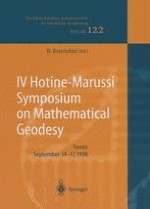2001 | OriginalPaper | Buchkapitel
Distance Measurement with Electromagnetic Wave Dispersion
verfasst von : Michele Caputo
Erschienen in: IV Hotine-Marussi Symposium on Mathematical Geodesy
Verlag: Springer Berlin Heidelberg
Enthalten in: Professional Book Archive
Aktivieren Sie unsere intelligente Suche, um passende Fachinhalte oder Patente zu finden.
Wählen Sie Textabschnitte aus um mit Künstlicher Intelligenz passenden Patente zu finden. powered by
Markieren Sie Textabschnitte, um KI-gestützt weitere passende Inhalte zu finden. powered by
An atmosphere above a half space considered with the dispersion represented by a relation between the electric field and the induction which contains derivatives of rational order and is similar to the empirical formula of Cole and (1941), commonly used in experimental physics, and to the formula used by (1991) in studying the dispersion of energy in electric networks. The dispersion of a monochromatic wave is modelled considering the index of refraction n as a rational function of a rational power of the imaginary frequency if, as usually in geophysics, and is a polymorphic function of f; this function, for each frequency, gives a set of different velocity fields, whose number depends on the rational exponent of if. Each electromagnetic wave leaving the source, with given f and direction, is split in a number of waves with different velocities; if n is a function of position, the paths of the waves are different and reach a given elevation at different points and times. If n is independent of the position, the paths of the waves coincide although the waves have different velocities. The length of a path and the travel time of electromagnetic waves in the atmosphere of a flat Earth model are computed. It is found that the difference between the arc length of the ray and the chord is nil to the second order of refractivity. It is also seen that a change of water content is layers of the atmosphere, leaving the average velocity profile to a given elevation unchanged, may change the length of the ray paths to the elevation. It is found that the separation of the rays with the same frequency and direction at the source, causes small uncertainties in electromagnetic distance measurements which increase with the frequency. In the (1985) atmospheric model we considered frequencies in the range 1 GHz to 2 GHz and found that the arrival of the phases of the rays, with the same frequency in this range, with a zenithal angle smaller that 27π/5 and that a distance of about 104 km, are spread in less than 0.01 ns or 0.3 cm; which does not influence the accuracy presently achieved in distance measurements with electromagnetic waves. The dissipation of energy of the rays in the atmospheric model used, for zenithal angles smaller than 27π/5, is negligible for any length of the path. Formulae are given for the retrieval of a spherical model of the atmosphere of the Earth from a set of differences of the times of arrival, at two observing stations, of the waves emitted from satellites of known orbits.
